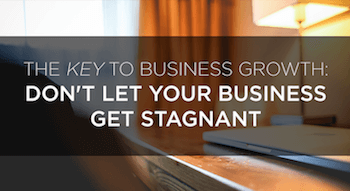The key to organic business growth: Don’t let your business get stagnant
“What is the difference between a living thing and a dead thing? In the medical world, a clinical definition of death is a body that does not change. Change is life. Stagnation is death. If you don’t change, you die. It’s that simple. It’s that scary.” – Leonard Sweet
Let’s face it. The last four or five years have not been boom years for small business. If your business is growing; well done. You are beating the averages. But for most businesses with 20 or fewer employees, while we are back to pre-recession levels, growth has been elusive.
There are loads of reasons for this, many of which are beyond our control. But one of the strengths of being a small business is that we actually have more control, when it comes to shaping our destiny, than, say, a big corporation. No, we are not immune to the ups-and-downs of the larger economy; but the beauty of owning a small business is that we can make changes faster, and we are freer to seek business where it can be found. There is risk involved. Isn’t there always? Making changes and finding new ways to do things is hard. But the opportunity to switch things up is there, if we want it.
So, if 2015 is the year that you have decided “enough is enough”–and you want to get growing again, we’ve got three “proverbs” to guide you along the way.
If nothing changes, then nothing changes
Economically speaking, nothing is going back to “the way it used to be”. You won’t find growth by looking backward. If you want to find growth, you need to look for it in new places–places you haven’t been before. You may need to shift your business model, or your service offering, or your pricing. You may need to challenge your assumptions about what can be sold online and what can’t. The point is that what you had doesn’t matter any more–you’re starting over with a blank slate. How are you going to do it now?
We all have our comfort zone, which is some version of a level of business that keeps us out of poverty and doesn’t cause us too many headaches. It’s a nice place to rest. But if you want to grow–if you need to break the cycle of stagnation–then you have to make that comfort zone uncomfortable. Some of this can be a shift in your mindset; like, I’m not going to settle for “out of poverty”. Instead I’m going to get paid what I deserve to make! Some of it might be hiring some hot new talent that is going to push you for better clients and more interesting work. But there has to be something that makes it “not OK” to stay in that zone.
What gets measured gets done
One way to break through that complacency is to have someone hold you accountable to real numbers. Create a budget–not just for expenses–but for new sales. Create a plan to take actions that cause sales, then measure the results. If your actions aren’t causing sales, you are failing. Someone should be disappointed. Someone should force you to look at those results and make changes to improve them. It’s very hard to do that unless you have someone from outside the company holding you accountable.
Who holds you accountable? What are you willing to be held accountable to? If you goal is growth, and you aren’t growing, who’s looking at the numbers and telling you that’s not OK?
Change begins with you
“Everyone thinks of changing the world, but no one thinks of changing himself.”
― Leo Tolstoy
As the leader of your business, you are the one who needs to create the change that your business needs. Usually that means making changes in how you think, attitudes you have, assumptions you’ve held. If you want different results from the same thinking and the same actions…well, that’s just crazy, right? So how are you going to get yourself into a different head space?
- Reach out to some other business owners and try to see the world through their eyes. What do they see that you don’t see? Try this with someone 10 years (or more) younger than you!
- Take your youngest employees out to lunch and ask for their opinions about your industry. Where do they see it going? What is it going to look like in 5 – 10 years? Then imagine what would have to happen for their predictions to come to pass.
- Look at 5 businesses that are experiencing growth outside of your industry. Why are they growing? How is their business model different from yours? How could you adapt that model for your industry?
To gain that new insight, we need to give up some of our biases. We need to let go of the all the lessons we “learned the hard way”. We need to take a step back, and look at the world with new eyes.
If 2015 is the your year to get growing again, look in the mirror first; then start making changes. This is hard work, but you don’t have to do it alone! Give us a shout. We’re more than happy to find someone to walk with you, who can help you through any switch, shift, or transition, to get your company on a path of growth.
Photo credit: Jim Larrison

